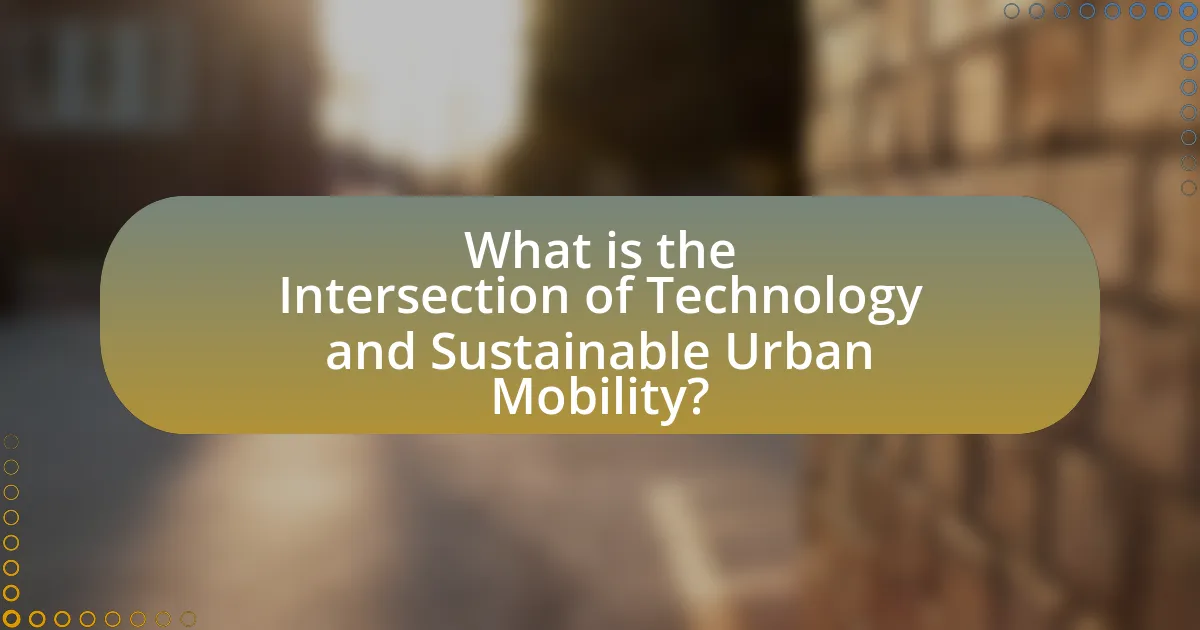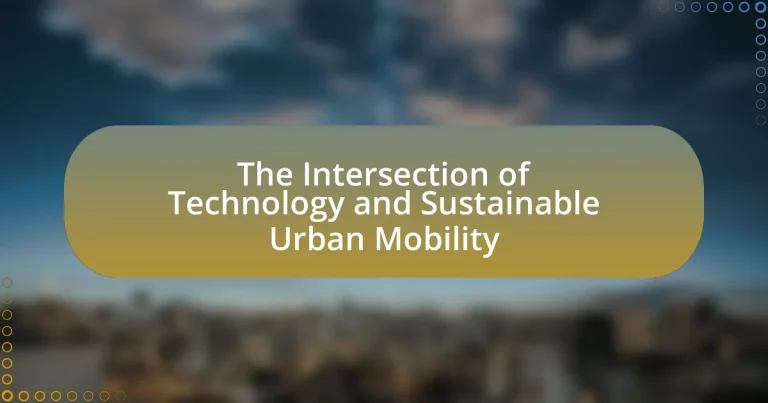The article focuses on the intersection of technology and sustainable urban mobility, highlighting how innovative technologies enhance transportation systems while minimizing environmental impacts. It discusses key technologies such as electric vehicles, smart traffic management systems, and mobility-as-a-service platforms, which contribute to reduced greenhouse gas emissions and improved accessibility. The article also addresses the benefits of these technologies in optimizing urban mobility, the challenges cities face, and the role of data analytics in shaping future transportation solutions. Additionally, it explores the potential of electric and autonomous vehicles in promoting sustainability and the importance of public-private partnerships in advancing urban mobility technologies.

What is the Intersection of Technology and Sustainable Urban Mobility?
The intersection of technology and sustainable urban mobility refers to the integration of innovative technologies to enhance transportation systems while minimizing environmental impact. Technologies such as electric vehicles, smart traffic management systems, and mobility-as-a-service platforms facilitate efficient, eco-friendly transportation options. For instance, the adoption of electric vehicles can significantly reduce greenhouse gas emissions, with studies indicating that electric cars produce up to 50% fewer emissions compared to traditional gasoline vehicles. Additionally, smart traffic management systems utilize real-time data to optimize traffic flow, reducing congestion and associated emissions. This synergy between technology and sustainable practices is crucial for developing urban environments that prioritize both mobility and environmental sustainability.
How do technology and sustainable urban mobility interact?
Technology enhances sustainable urban mobility by optimizing transportation systems, reducing emissions, and improving accessibility. For instance, smart traffic management systems utilize real-time data to minimize congestion, which leads to lower fuel consumption and reduced greenhouse gas emissions. Additionally, electric vehicles, supported by advancements in battery technology, contribute to cleaner urban environments by replacing fossil fuel-powered transportation. According to the International Energy Agency, electric vehicles could reduce global CO2 emissions by up to 1.5 gigatons annually by 2030. Furthermore, mobile applications facilitate ride-sharing and public transport integration, promoting efficient use of resources and decreasing reliance on personal vehicles. These interactions demonstrate that technology is crucial in advancing sustainable urban mobility initiatives.
What are the key technologies influencing urban mobility?
Key technologies influencing urban mobility include electric vehicles (EVs), autonomous vehicles (AVs), smart traffic management systems, and mobility-as-a-service (MaaS) platforms. Electric vehicles reduce greenhouse gas emissions and reliance on fossil fuels, with global EV sales reaching 6.6 million units in 2021, according to the International Energy Agency. Autonomous vehicles enhance safety and efficiency, with companies like Waymo and Tesla leading in development. Smart traffic management systems utilize real-time data to optimize traffic flow, reducing congestion and travel times. Mobility-as-a-service platforms integrate various transportation modes, allowing users to plan and pay for their journeys seamlessly, thereby promoting public transport usage and reducing private vehicle dependency.
How does sustainable urban mobility benefit from technological advancements?
Sustainable urban mobility benefits from technological advancements by enhancing efficiency, reducing emissions, and improving accessibility. Technologies such as electric vehicles, smart traffic management systems, and real-time public transport tracking contribute to lower greenhouse gas emissions and decreased reliance on fossil fuels. For instance, the deployment of electric buses in cities has been shown to reduce emissions by up to 50% compared to traditional diesel buses. Additionally, smart mobility solutions, including ride-sharing apps and integrated transport platforms, facilitate seamless travel options, making public transport more attractive and accessible. These advancements not only promote environmental sustainability but also improve the overall quality of urban life by reducing congestion and travel times.
Why is sustainable urban mobility important in today’s cities?
Sustainable urban mobility is crucial in today’s cities because it reduces environmental impact, enhances public health, and improves quality of life. Urban areas are responsible for approximately 70% of global greenhouse gas emissions, making sustainable transportation essential for combating climate change. Furthermore, sustainable mobility solutions, such as public transit, cycling, and walking, promote physical activity, which can decrease obesity rates and related health issues. Studies indicate that cities implementing sustainable mobility strategies experience increased economic growth and social equity, as they provide accessible transportation options for all residents.
What challenges do cities face regarding urban mobility?
Cities face significant challenges regarding urban mobility, including traffic congestion, inadequate public transportation infrastructure, and environmental sustainability. Traffic congestion leads to increased travel times and economic losses; for instance, in 2021, congestion cost U.S. drivers approximately $166 billion in wasted time and fuel. Inadequate public transportation infrastructure limits access to jobs and services, with over 45% of urban residents in developing countries lacking reliable transit options. Environmental sustainability is also a pressing issue, as urban areas contribute to over 70% of global greenhouse gas emissions, necessitating a shift towards greener mobility solutions. These challenges require integrated approaches that leverage technology and sustainable practices to enhance urban mobility systems.
How does sustainable urban mobility contribute to environmental goals?
Sustainable urban mobility contributes to environmental goals by reducing greenhouse gas emissions and improving air quality. By promoting public transportation, cycling, and walking, cities can decrease reliance on fossil fuel-powered vehicles, which are significant sources of carbon dioxide and other pollutants. For instance, a study by the International Transport Forum found that shifting to public transport can reduce emissions by up to 45% in urban areas. Additionally, sustainable mobility initiatives often incorporate green technologies, such as electric buses and bike-sharing programs, further enhancing their positive environmental impact.

What role does technology play in enhancing sustainable urban mobility?
Technology plays a crucial role in enhancing sustainable urban mobility by enabling efficient transportation systems and reducing environmental impacts. Innovations such as electric vehicles, smart traffic management systems, and real-time public transit information contribute to lower emissions and improved accessibility. For instance, electric vehicles produce zero tailpipe emissions, significantly decreasing urban air pollution. Additionally, smart traffic management systems utilize data analytics to optimize traffic flow, reducing congestion and travel times. According to a study by the International Transport Forum, implementing smart mobility solutions can lead to a 20% reduction in urban transport emissions. Thus, technology not only facilitates more sustainable transportation options but also enhances the overall efficiency of urban mobility systems.
How are smart transportation systems implemented in urban areas?
Smart transportation systems are implemented in urban areas through the integration of advanced technologies such as IoT, data analytics, and real-time communication. These systems utilize sensors and connected devices to monitor traffic conditions, optimize public transit routes, and enhance overall mobility. For instance, cities like Barcelona have deployed smart traffic lights that adjust based on real-time traffic flow, reducing congestion and improving travel times. Additionally, the use of mobile applications allows users to access real-time information about public transportation options, further promoting efficient urban mobility. The effectiveness of these implementations is supported by studies showing that smart transportation solutions can reduce travel times by up to 20% and decrease emissions significantly, contributing to sustainable urban development.
What technologies are used in smart transportation systems?
Smart transportation systems utilize various technologies, including Internet of Things (IoT) devices, artificial intelligence (AI), big data analytics, and connected vehicles. IoT devices enable real-time data collection from vehicles and infrastructure, facilitating efficient traffic management. AI algorithms analyze this data to optimize routes and reduce congestion. Big data analytics processes vast amounts of information to improve decision-making and enhance user experiences. Connected vehicles communicate with each other and infrastructure, promoting safety and efficiency. These technologies collectively contribute to more sustainable urban mobility by reducing emissions and improving transportation efficiency.
How do smart transportation systems improve efficiency and sustainability?
Smart transportation systems enhance efficiency and sustainability by utilizing advanced technologies to optimize traffic flow and reduce emissions. These systems employ real-time data analytics, which allows for better route planning and traffic management, leading to decreased congestion. For instance, cities implementing adaptive traffic signals have reported reductions in travel time by up to 30%, which directly correlates with lower fuel consumption and greenhouse gas emissions. Additionally, smart transportation systems promote the use of public transit and non-motorized transport options, further contributing to sustainability by decreasing reliance on personal vehicles. Studies indicate that cities with integrated smart transportation solutions can achieve a 20% reduction in overall transportation-related emissions, demonstrating their effectiveness in fostering both efficiency and environmental responsibility.
What are the impacts of electric and autonomous vehicles on urban mobility?
Electric and autonomous vehicles significantly enhance urban mobility by reducing traffic congestion, lowering emissions, and improving accessibility. The integration of electric vehicles (EVs) contributes to cleaner air quality, as they produce zero tailpipe emissions, which is crucial in densely populated urban areas. Autonomous vehicles (AVs) optimize traffic flow through advanced algorithms that reduce stop-and-go driving, thereby decreasing travel times and fuel consumption.
Studies indicate that widespread adoption of EVs could reduce greenhouse gas emissions from the transportation sector by up to 80% by 2050, according to the International Energy Agency. Furthermore, AVs can increase road safety by minimizing human error, which accounts for approximately 94% of traffic accidents, as reported by the National Highway Traffic Safety Administration. Together, these technologies promote a shift towards more sustainable urban environments, enhancing the overall quality of life for city residents.
How do electric vehicles contribute to sustainability in urban settings?
Electric vehicles (EVs) contribute to sustainability in urban settings by reducing greenhouse gas emissions and improving air quality. Unlike traditional internal combustion engine vehicles, EVs produce zero tailpipe emissions, which significantly lowers urban air pollution levels. According to a study by the Union of Concerned Scientists, EVs can reduce emissions by up to 70% compared to gasoline vehicles when considering the entire lifecycle, including electricity generation. Additionally, the adoption of EVs encourages the development of renewable energy sources, as cities increasingly integrate solar and wind power into their energy grids to charge these vehicles, further enhancing sustainability efforts.
What are the potential benefits and challenges of autonomous vehicles?
Autonomous vehicles offer significant benefits, including enhanced safety, reduced traffic congestion, and increased mobility for individuals unable to drive. Studies indicate that autonomous vehicles could reduce traffic accidents by up to 90% due to their ability to eliminate human error, which accounts for approximately 94% of crashes according to the National Highway Traffic Safety Administration. Additionally, these vehicles can optimize traffic flow through advanced algorithms, potentially decreasing congestion and travel times.
However, challenges also exist, such as regulatory hurdles, cybersecurity risks, and public acceptance. The lack of comprehensive regulations can hinder the deployment of autonomous vehicles, as different jurisdictions may have varying laws. Cybersecurity is a critical concern, as these vehicles rely on complex software systems that could be vulnerable to hacking. Furthermore, public acceptance remains a challenge, with surveys indicating that many individuals are hesitant to trust autonomous technology, which could slow adoption rates.

What are the future trends in technology and sustainable urban mobility?
Future trends in technology and sustainable urban mobility include the widespread adoption of electric vehicles (EVs), the integration of smart transportation systems, and the rise of shared mobility solutions. Electric vehicles are projected to dominate the market, with global sales expected to reach 30% of total vehicle sales by 2030, driven by advancements in battery technology and government incentives. Smart transportation systems, utilizing data analytics and IoT, will enhance traffic management and reduce congestion, as evidenced by cities like Barcelona implementing smart traffic lights that adapt to real-time conditions. Additionally, shared mobility services, such as ride-hailing and bike-sharing, are anticipated to grow, with the shared mobility market projected to reach $1.5 trillion by 2030, reflecting a shift towards more sustainable and efficient urban transport options.
How is data analytics shaping urban mobility solutions?
Data analytics is significantly shaping urban mobility solutions by enabling data-driven decision-making that optimizes transportation systems. Through the analysis of real-time data from various sources, such as traffic patterns, public transit usage, and user behavior, cities can enhance route planning, reduce congestion, and improve service efficiency. For instance, cities like Los Angeles have implemented data analytics to analyze traffic flow, resulting in a 10% reduction in travel time for commuters. Additionally, predictive analytics helps in anticipating demand for rideshare services, allowing companies to allocate resources more effectively. This integration of data analytics not only improves the user experience but also contributes to more sustainable urban mobility by promoting efficient resource use and reducing emissions.
What types of data are most valuable for improving urban mobility?
The most valuable types of data for improving urban mobility include real-time traffic data, public transportation usage statistics, pedestrian and cyclist movement patterns, and geographic information system (GIS) data. Real-time traffic data helps identify congestion points and optimize traffic signal timings, while public transportation usage statistics reveal demand patterns that can inform service adjustments. Additionally, understanding pedestrian and cyclist movement patterns enhances infrastructure planning, and GIS data provides spatial context for all mobility-related analyses. Collectively, these data types enable cities to make informed decisions that enhance mobility efficiency and sustainability.
How can cities leverage data analytics for better transportation planning?
Cities can leverage data analytics for better transportation planning by utilizing real-time data to optimize traffic flow and improve public transit systems. By analyzing data from sources such as GPS, traffic cameras, and mobile applications, cities can identify congestion patterns and peak travel times. For instance, a study by the National Academy of Sciences found that cities using data analytics can reduce traffic congestion by up to 30% through informed decision-making and resource allocation. Additionally, predictive analytics can help in forecasting future transportation needs, allowing for proactive infrastructure development. This data-driven approach enhances the efficiency of transportation networks, ultimately leading to reduced travel times and improved urban mobility.
What innovations are on the horizon for sustainable urban mobility?
Innovations on the horizon for sustainable urban mobility include electric and autonomous vehicles, smart public transportation systems, and integrated mobility platforms. Electric vehicles (EVs) are projected to dominate urban transport, with global sales expected to reach 30% of total vehicle sales by 2030, driven by advancements in battery technology and charging infrastructure. Autonomous vehicles are anticipated to enhance safety and efficiency, with companies like Waymo and Tesla leading trials in urban environments. Smart public transportation systems, utilizing real-time data and AI, aim to optimize routes and reduce wait times, improving user experience. Integrated mobility platforms, such as MaaS (Mobility as a Service), are emerging to combine various transport modes into a single accessible service, promoting seamless travel and reducing reliance on personal vehicles. These innovations collectively contribute to reducing carbon emissions and enhancing urban livability.
How might emerging technologies like AI and IoT transform urban mobility?
Emerging technologies like AI and IoT can significantly transform urban mobility by enhancing efficiency, safety, and user experience. AI algorithms can optimize traffic flow through real-time data analysis, reducing congestion and travel times. For instance, cities implementing AI-driven traffic management systems have reported up to a 30% decrease in delays. IoT devices, such as connected vehicles and smart traffic signals, facilitate seamless communication between infrastructure and users, enabling adaptive responses to changing conditions. Research indicates that cities utilizing IoT for public transport can improve service reliability by 20%, leading to increased ridership. Together, these technologies create a more integrated and responsive urban mobility ecosystem, ultimately promoting sustainable transportation solutions.
What role do public-private partnerships play in advancing urban mobility technologies?
Public-private partnerships (PPPs) play a crucial role in advancing urban mobility technologies by facilitating collaboration between government entities and private sector companies. These partnerships enable the pooling of resources, expertise, and innovation, which accelerates the development and deployment of smart transportation solutions. For instance, cities like Los Angeles have engaged in PPPs to implement advanced traffic management systems, resulting in a 20% reduction in congestion during peak hours. Additionally, PPPs can leverage private investment to fund infrastructure projects, such as electric vehicle charging stations, which are essential for promoting sustainable urban mobility. By aligning the interests of both sectors, PPPs effectively drive technological advancements that enhance urban transportation systems.
What best practices can cities adopt for integrating technology into sustainable urban mobility?
Cities can adopt best practices such as implementing smart traffic management systems, promoting electric and shared mobility solutions, and utilizing data analytics for urban planning to integrate technology into sustainable urban mobility. Smart traffic management systems, which use real-time data to optimize traffic flow, can reduce congestion and emissions; for example, cities like Los Angeles have reported a 20% reduction in travel time through such systems. Promoting electric vehicles and shared mobility options, such as bike-sharing and ride-sharing services, can decrease reliance on personal vehicles, as seen in cities like Amsterdam, where bike usage accounts for 38% of all trips. Additionally, leveraging data analytics allows cities to make informed decisions about infrastructure investments and public transport routes, enhancing overall efficiency and sustainability.


